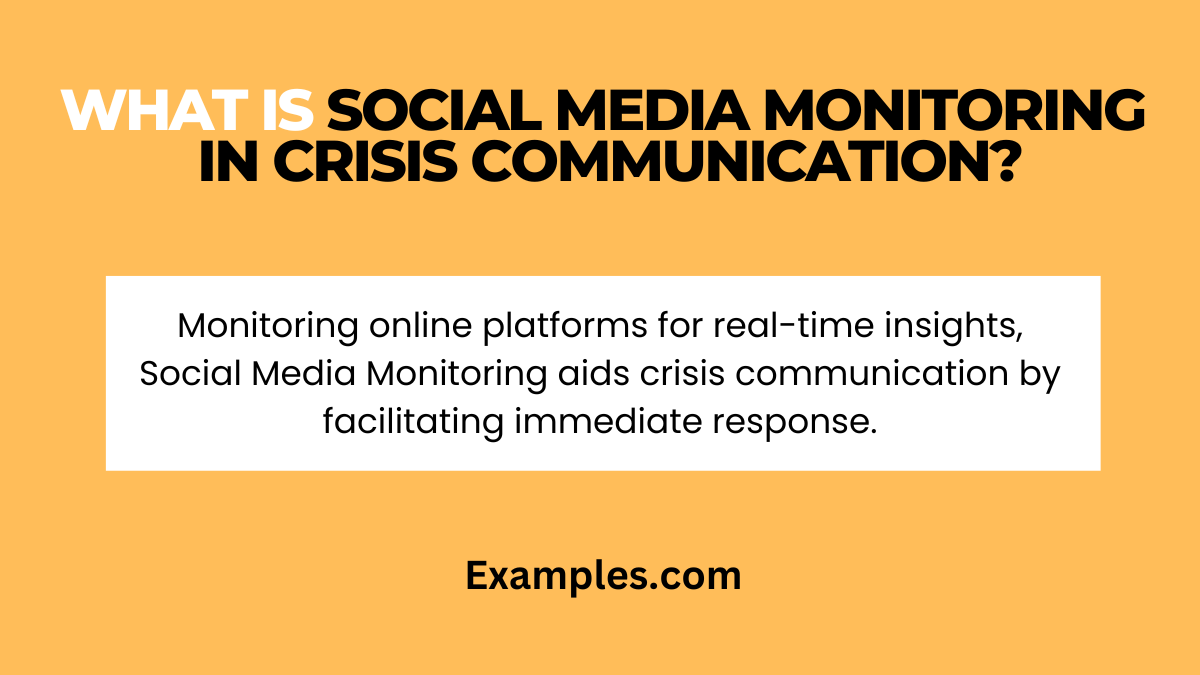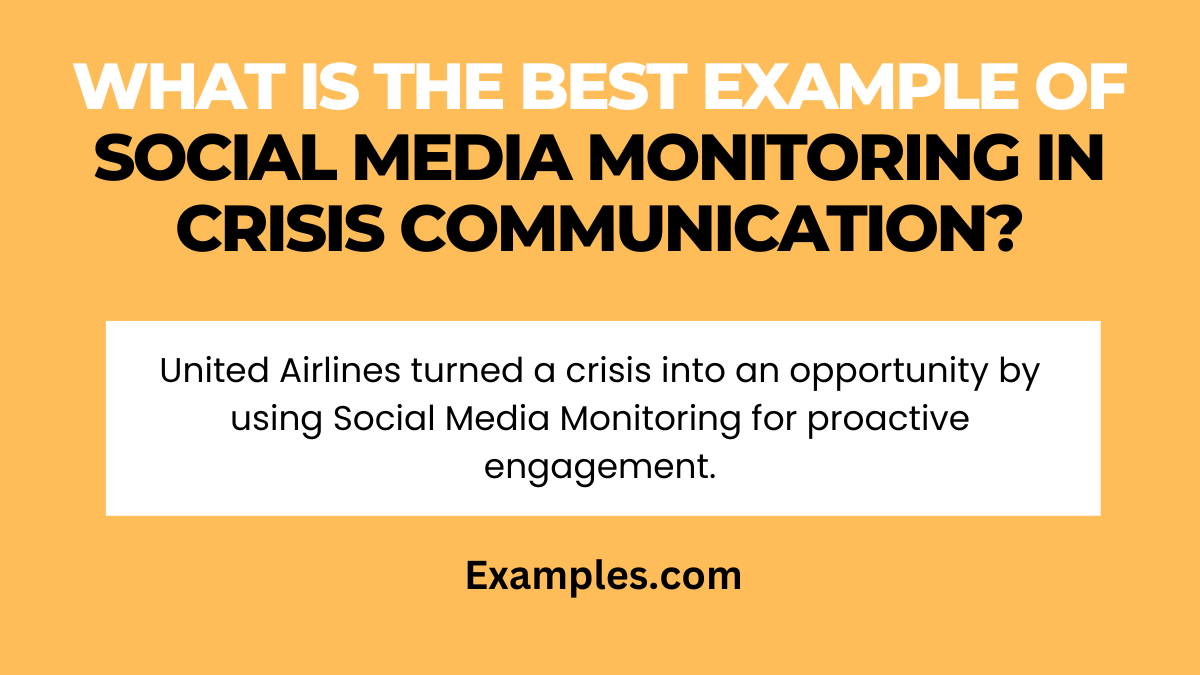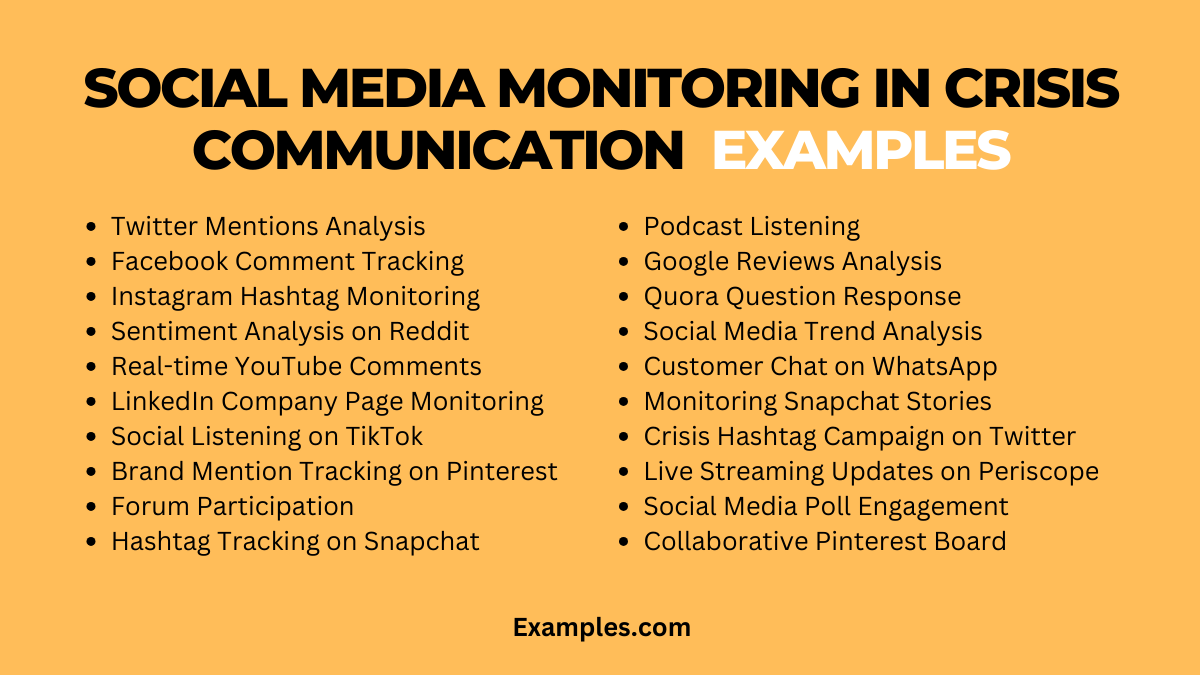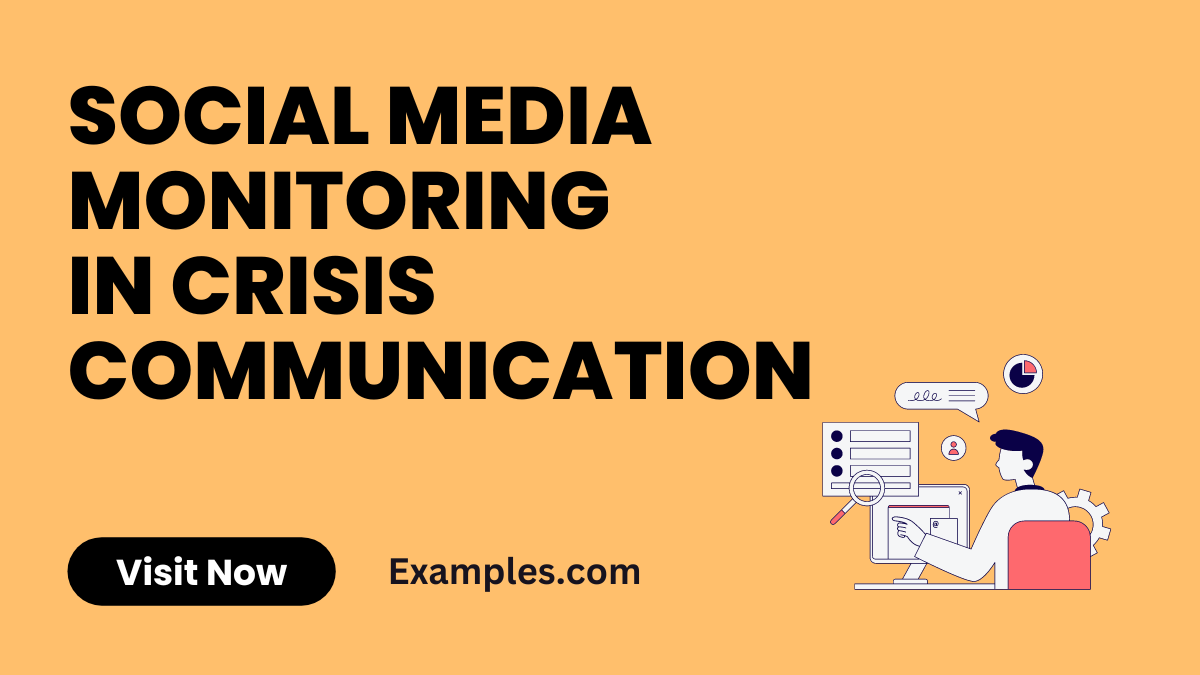19+ Social Media Monitoring in Crisis Communication Examples
Unlock the art of crisis communication with our comprehensive guide to Social Media Monitoring. Discover proven strategies, actionable tips, and communication examples that empower you to navigate turbulent times in the digital landscape. Dive into this resourceful guide for a holistic approach to crisis management and effective communication in the fast-paced world of social media.
What is Social Media Monitoring in Crisis Communication?

Social Media Monitoring in Crisis Communication involves systematically tracking and analyzing digital platforms to gain real-time insights. It helps organizations stay ahead of emerging issues, manage reputations, and implement effective communication strategies during crises. This proactive approach enhances responsiveness, allowing businesses to address concerns swiftly and maintain public trust in the dynamic realm of social media.
What is the Best Example of Social Media Monitoring in Crisis Communication?

During a crisis involving flight disruptions, United Airlines utilized Social Media Monitoring effectively. By actively tracking online conversations, they identified passenger complaints swiftly. Responding in real-time, United Airlines addressed concerns, provided updates, and offered solutions. This proactive engagement showcased the airline’s commitment to customer satisfaction. Social Media Monitoring enabled them to turn a potentially damaging situation into an opportunity to demonstrate responsiveness, transparency, and dedication to resolving issues promptly.
20 Social Media Monitoring in Crisis Communication Examples

- Twitter Mentions Analysis: XYZ Corp monitored Twitter during a product recall, identifying concerns and updating transparently.
- Facebook Comment Tracking: ABC Co. tracked post-crisis comments, engaging users with personalized responses efficiently.
- Instagram Hashtag Monitoring: XYZ Telecom monitored Instagram during a service outage, acknowledging frustrations and providing real-time updates.
- Sentiment Analysis on Reddit: ABC Retail analyzed Reddit sentiment post-crisis, tailoring communication to regain customer trust.
- Real-time YouTube Comments Engagement: XYZ Gaming addressed YouTube comments promptly, turning potential backlash into positive sentiment through direct communication.
- LinkedIn Company Page Monitoring: ABC Corp monitored LinkedIn during a crisis, using professional communication to reassure stakeholders.
- Social Listening on TikTok: XYZ Apparel creatively responded to TikTok videos expressing concerns, showcasing agility in crisis communication.
- Brand Mention Tracking on Pinterest: ABC Home Decor tracked Pinterest brand mentions post-crisis, using visually appealing content to communicate resolutions.
- Forum Participation: XYZ Software actively engaged in relevant forums, providing step-by-step guidance during a software glitch.
- Hashtag Tracking on Snapchat: ABC Events tracked Snapchat hashtags during a crisis, addressing concerns and using snaps for effective updates.
- Podcast Listening: XYZ Health monitored podcast discussions during a healthcare crisis, participating to clarify misinformation.
- Google Reviews Analysis: ABC Restaurant addressed negative Google reviews post-food safety concerns, demonstrating accountability.
- Quora Question Response: XYZ Travel addressed travel concerns on Quora, providing detailed responses to reassure users.
- Social Media Trend Analysis: ABC Tech used trend analysis during a product recall to align with public sentiments.
- Customer Chat on WhatsApp: XYZ E-commerce monitored customer chats on WhatsApp, offering immediate support during a service disruption.
- Monitoring Snapchat Stories: ABC Fashion tracked Snapchat stories, incorporating user-generated content in crisis communication.
- Crisis Hashtag Campaign on Twitter: XYZ NGO initiated a Twitter hashtag campaign, encouraging community engagement during challenging times.
- Live Streaming Updates on Periscope: ABC News used Periscope for live updates, fostering real-time interaction during a crisis.
- Social Media Poll Engagement: XYZ Sports Team engaged fans through polls during a controversial event, tailoring communication based on sentiments.
- Collaborative Pinterest Board: ABC Wedding Services created a collaborative Pinterest board during a service glitch, fostering a sense of community.
Social Media Monitoring in Crisis Communication Examples for Students
In student-focused crises, social media monitoring is vital. Timely responses and empathetic engagement can mitigate concerns, fostering a supportive environment.
- Facebook Group Updates: Students actively share concerns on a crisis-focused Facebook group. Institutions respond promptly, providing accurate information and emotional support.
- Twitter Live Q&A Session: Hosting live Q&A sessions on Twitter allows students to voice concerns and receive immediate responses, ensuring transparent communication during uncertain times.
- Instagram Story Announcements: Using Instagram Stories, educational institutions share real-time updates, addressing student queries and providing reassurance amid crises.
- Snapchat Campus Alerts: Utilizing Snapchat for campus alerts ensures instant communication, offering safety tips and updates during emergencies.
- WhatsApp Crisis Helpline: Establishing a crisis helpline on WhatsApp allows students to seek confidential support, promoting mental well-being and addressing personal concerns.
Social Media Monitoring in Crisis Communication Examples for Companies
For companies facing crises, effective social media monitoring enhances brand resilience. Proactive strategies and transparent communication rebuild trust and maintain customer loyalty.
- Twitter Customer Support: Swift responses on Twitter address customer concerns, demonstrating commitment to resolution and enhancing brand trust during product-related crises.
- LinkedIn Crisis Updates: Companies share detailed crisis updates on LinkedIn, reassuring stakeholders with transparent communication and showcasing corporate responsibility.
- YouTube Live Product Briefing: Hosting live product briefings on YouTube provides real-time updates, addressing issues transparently and rebuilding confidence amid a product recall.
- Facebook Community Engagement: Companies actively engage with customers in crisis-focused Facebook communities, using personalized responses to address concerns and strengthen customer relationships.
- Instagram Crisis Communication Campaign: Utilizing Instagram for crisis campaigns, companies share visually appealing content, showcasing corrective actions and reinforcing a positive brand image during challenging times.
Why is Social Media Monitoring Important for Crisis Communication?
Social media monitoring is crucial for real-time crisis awareness, enabling swift responses, mitigating misinformation, and fostering transparent communication, enhancing brand reputation and customer trust.
- Real-time Awareness: Monitor social media for instant crisis awareness, staying informed about emerging issues and sentiments.
- Swift Responses: Actively engage to provide timely responses, addressing concerns promptly and preventing the escalation of issues.
- Mitigate Misinformation: Identify and counteract misinformation effectively, ensuring accurate information dissemination during crises.
- Transparent Communication: Foster transparent communication by sharing real-time updates, corrective actions, and empathetic messages with stakeholders.
- Enhance Brand Reputation: Proactive social media monitoring safeguards brand reputation, showing accountability and commitment to resolving issues.
How to Improve Crisis Communication with Social Media Monitoring?
Leverage social media monitoring tools to enhance crisis communication. Implement strategies for effective engagement, rapid response, and reputation management during challenging situations.
- Utilize Monitoring Tools: Employ advanced social media monitoring tools to track mentions, sentiments, and emerging crisis-related topics.
- Develop Response Protocols: Establish clear response protocols for various crisis scenarios, ensuring a structured and efficient communication approach.
- Engage Proactively: Actively engage with stakeholders on social platforms, providing regular updates and addressing concerns to build trust.
- Implement Rapid Response: Enable rapid response mechanisms, allowing immediate reactions to emerging crises and preventing the spread of misinformation.
- Integrate with Crisis Plans: Integrate social media monitoring seamlessly into overall crisis communication plans, ensuring a cohesive and comprehensive approach.
What is the Use of Social Media Monitoring in Crisis Communication?
Social media monitoring serves as a strategic tool for crisis communication, offering real-time insights, facilitating proactive responses, and maintaining brand credibility by addressing concerns effectively during challenging situations.
- Real-time Insights: Gain real-time insights into public sentiments, concerns, and emerging crisis-related discussions on social media platforms.
- Proactive Responses: Use monitoring data to proactively address issues, providing immediate responses and solutions to mitigate potential crises.
- Brand Credibility: Maintain brand credibility by promptly addressing concerns, sharing accurate information, and showcasing a commitment to customer satisfaction.
- Issue Identification: Quickly identify and assess potential crises through social media monitoring, allowing organizations to address issues before they escalate.
- Stakeholder Engagement: Actively engage with stakeholders during crises, using social media platforms to communicate transparently, express empathy, and reinforce brand values.
In conclusion, Social Media Monitoring is indispensable for effective crisis communication. By providing real-time insights, facilitating rapid responses, and maintaining transparent communication, organizations can navigate crises successfully. The examples and strategies presented serve as a comprehensive guide, emphasizing the critical role social media monitoring plays in safeguarding brand reputation and building trust during challenging situations.



